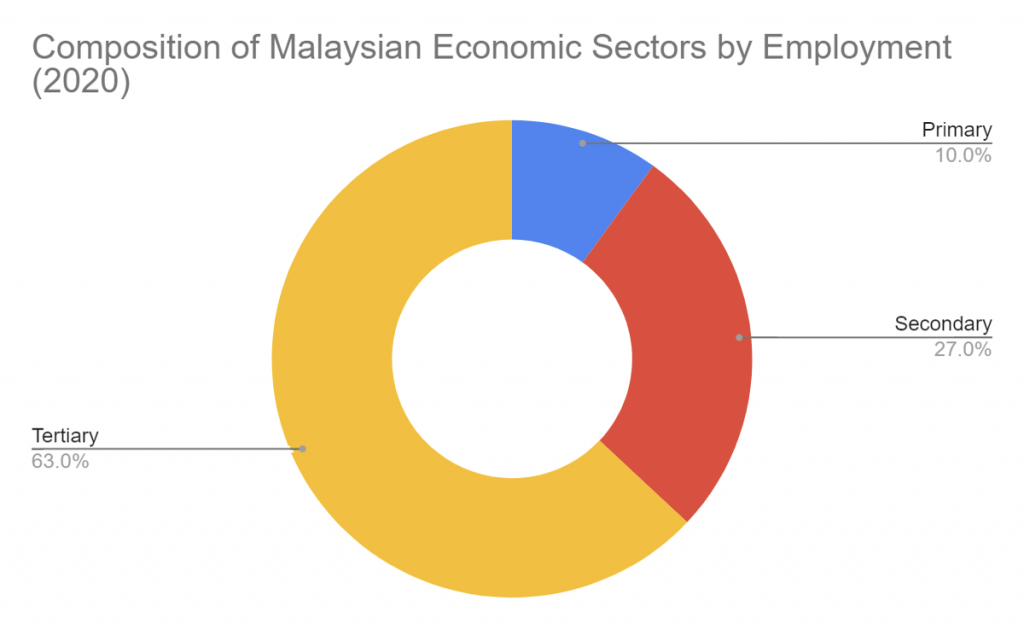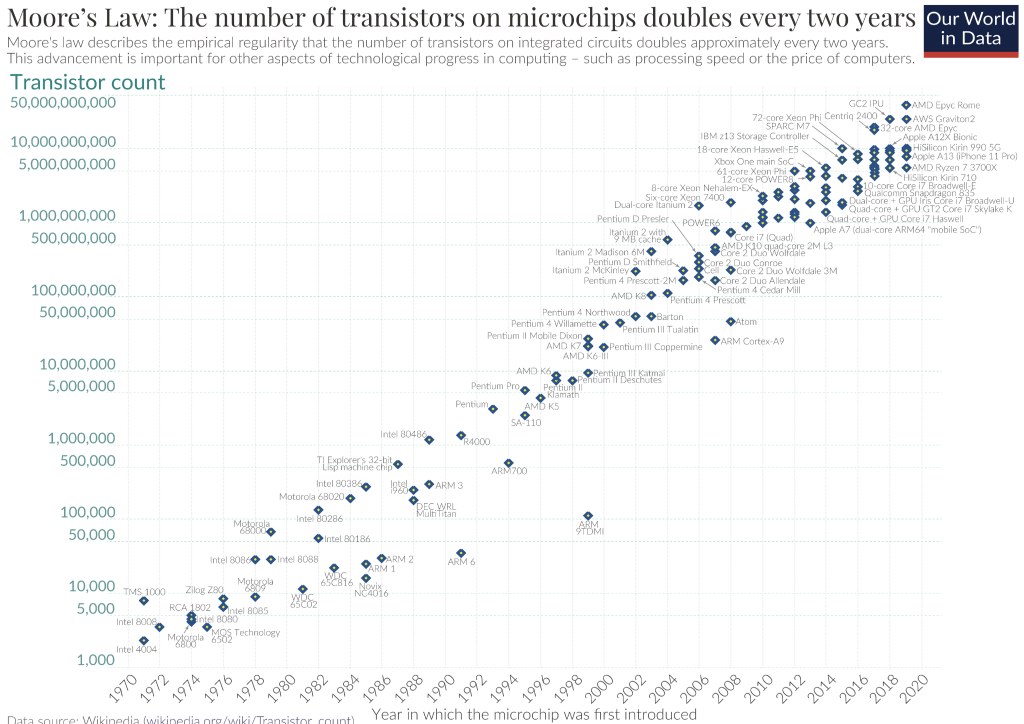
Author: Zheng Nam Jordan Tan
Mentor: Dr. Beryl Chang
The Alice Smith School, Malaysia
Abstract
Moore’s Law observes that the number of transistors on integrated circuits doubles approximately every two years. The accelerating pace of technological development brings about the advent of AI and automation on an unprecedented scale- It is estimated that 40-50% of workers with low education are at risk of automation by the mid-2030s (Hawksworth, John et al. 2018). This report explores the economic conflicts and consequences for Malaysia with a large-scale rollout of automation. I argue that: (i)Large firms will profit the most from automation and will need to be taxed accordingly; (ii) most low-skilled Malaysian workers will be rendered unemployed, thereby inflaming social tensions; (iii) the Malaysian government must play an active role in upskilling and supporting workers in an equitable manner through the introduction of a capital gains tax and stricter anti-corruption laws; (iv) Malaysians ought to establish a worker-cooperative system, much like the Mondragon Corporation so that workers will be able to engage in decisions on technological advancements. This report aims to bring to light the benefits and drawbacks of automation and policy changes with how Malaysia could benefit from them ultimately.
1. Introduction
Being the fourth-largest economy in Southeast Asia, Malaysia’s economy has proven to be incredibly robust. Due to the high concentration of knowledge-based enterprises and the adoption of advanced manufacturing technology, Malaysia enjoys relatively high labor productivity, with labor productivity per hour increasing by 3.4% in 2020 (Department of Statistics, Malaysia, 2020). In addition, it is worth mentioning that a big part of Malaysia’s manual workforce consists of foreign workers, mainly from neighbouring countries like Indonesia, Bangladesh, Nepal and the Philippines. Furthermore, while possessing a strong middle class, Malaysia has a globally recognized friendly business environment, ranked twelfth globally by the World Bank in 2020 (Eknath, 2020). All these points to Malaysia having a healthy economy to adapt to the ever-changing global environment often disrupted by advancements in technologies.
As of 2021, Malaysia is still heavily reliant on its manufacturing and agricultural industries, which accounted for 44.7% of the GDP in 2019 (O’Neill, 2021). The automotive industry alone contributed to more than 4% of GDP and employed 700,000 workers in 2016 (Malaysia Automotive Institute, 2017). However, this is changing as Malaysia transitions to a post-industrial economy. The tertiary sector accounted for 48.84% of GDP in 2009 and has grown to 54.17% in 2019 (O’Neill, 2021). As a result, the tertiary and quaternary sectors will only grow in importance, and traditional manufacturing, mining and agricultural jobs will be, by and large, replaced with machinery.

Moore’s Law (Fig.2) observes that the number of transistors on integrated circuits doubles approximately every two years. This aspect of technological progress is essential as the capabilities of many digital electronic devices are strongly associated with Moore’s Law (Max Roser and Hannah Ritchie, 2013). This progress in technology is increasingly replacing labor. In an estimation by McKinsey & Company in 2020, automation could displace up to 25 per cent of hours, or 4.5 million equivalent workers, in Malaysia by 2030. Automation will have profound effects on the Malaysian economy, and the government will need to implement policies to ensure the welfare of the people. Increasing spending on education to produce a more highly skilled and adaptable workforce-as of 2019, only 21.3% of the working-age population are graduates with tertiary education. The demand for this skilled labor is only rising and will be a necessity in the digital age.

Fig. 2: Chart of exponential technological progress. Data Source: (Max Roser and Hannah Ritchie, 2013)
2. Benefits
Large firms who control the capital would benefit the most, should they replace half of their labor with technology. Technology requires an initial investment and regular maintenance. Still, it will cut production costs and increase overall productivity as machines can work 24 hours a day with little to no interruptions. As a result, firms’ revenues and profit margins will increase substantially. As firms’ profits increase, they can invest in training new workers and increase the wages of their employed workers, increasing their disposable income. This increase in disposable income would increase spending and drive more economic growth in the Malaysian economy as consumption makes up around 60% of nominal GDP in Malaysia(CEIC, 2021).With this rise in profits, firms will also have more capital to invest in research & development, further accelerating the advancement of technology and providing even more opportunities to expand by creating new products and exploring new markets.
Does it mean that 50% of the Malaysian labor force will be rendered unemployed if technology replaces 50% of the current jobs in the country? I believe that this will not be the case. Whilst old jobs will be displaced by automation, opportunities for new jobs and industries will also open up. We have seen this trend in the rise of the internet, with computer scientists in high demand as they have the skills and knowledge to maintain and operate the new technology. Of course, complete automation is not a process that will happen overnight. Displaced workers, who are willing and able to learn, will inevitably have to upskill their labor to adapt to the evolving labor market. Moreover, there will be opportunities for individuals who are ready and able to exploit new industries and markets built upon these new technologies.

Fig. 3: Chart of Schumpeter’s Creative Destruction Theory and Kondratiev’s Waves. Data Source: The Natural Edge Project
Workers may stand to benefit as technology plays a more significant role in their jobs. It can help increase their productivity, raising their income and shortening their working hours as a result. Malaysian exports could become more competitive globally due to a fall in price thanks to the increase in productivity from technology. Lower production costs in Malaysia would incentivize multinational companies to raise their foreign direct investment, stimulate the economy, encourage more job growth, and improve the workforce’s skills.
Another consequence of automation is that it protects workers from dangerous jobs. Sarawak, Johor and Selangor alone account for around 15%(Ayob, 2018) of fatalities from occupational accidents, from which industries such as manufacturing, construction and agriculture contribute significantly. In 2013 alone, 26 fell to their deaths working in Malaysia’s construction sector. Accidents are disastrous for all parties involved and are likely to halt production and increase costs to the firm. In addition, organizations can be forced to pay for compensation to the affected family, and even OSHA fines spanning upwards of RM200 000 (Kamel, 2021)if an inspection deems a regulation to be broken in the course of the fatality. However, Malaysia has been adopting the use of machinery in production over the past few decades. With 2019 marking the official use of 373 000 industrial robots (International Federation of Robotics, 2020) installed in manufacturing facilities, there is no doubt that such workplace incidents will continue to fall. Cobots or collaborative robots designed to work directly with humans have seen an 11% increase in demand than their traditional counterparts, assisting workers in carrying out tasks more safely while keeping them employed. The move to introduce technology to take on more hazardous tasks is likely to result in a net social gain to society, preventing such tragedies while preserving able workers who can contribute to the economy.
3. Implications
Due to the lack of tertiary education credentials, low-paying and low-skilled work are often taken up by the less educated. Advanced technologies quickly substitute such workers, and the tragic yet inevitable result is structural unemployment, meaning unemployment caused by changes in industrial structures and innovation of production technologies in this context. This would result in the reduction of income for lower-income groups, hence worsening the income disparity. Most workers in primary and secondary sectors, which compose 37% of the Malaysian workforce (Fig.1), could face unemployment due to automation in industries. Structural unemployment will prove an immense challenge for Malaysia’s limited welfare system. As of 2021, Malaysian citizens working in the private sector who have been made redundant can claim benefits through the Employment Insurance System Act 10, in which the unemployed can receive financial assistance for up to 6 months while continuing to look for a job . The Malaysian government will need to widen the scope of the unemployment benefit system and provide retraining schemes to maintain an active workforce.
Technological advancement is guaranteed to face much resistance from displaced workers who lack the ability and willingness to adapt to the changes. Facing a lack of labor market competencies, this phenomenon creates a series of problems for the unemployed:
- The unemployed would struggle to meet their everyday expenses such as food and accommodation costs due to not having a stable income, leading to a decrease in their living standards.
- A rise in the unemployment rate would worsen social problems and cause a rise in crime rate, eroding social cohesion and discouraging investors.
- Unemployment would mean that Malaysia’s labor resources are not being fully used in production, limiting national income.
- Unemployment significantly stifles economic development while decreasing effective demand at the same time. The unemployed, who have little to no purchasing power due to insufficient disposable income, would subsequently prove ineffective in contributing to the national aggregate demand in Malaysia, in which consumption plays a significant role.
Having millions of workers requiring government assistance would almost certainly trigger a recession. It will be essential to introduce the automation of industries in phases to ensure that there will not be an unsustainable spike in unemployment. The planned restructuring of production and service can open up new avenues for employing those whose work has been automated. Rather than working unnecessarily long hours, workers could work fewer hours and let the new technologies carry the heavy workload under this system. Increased unemployment from automation will be juxtaposed with the increase in profits and revenue for owners of firms, leading to higher levels of income inequality. In addition, the Malaysian government ought to increase taxes to fund its welfare system and improve its infrastructure. This could be achieved by introducing a capital gains tax, which Malaysia currently does not implement (Deloitte, 2017), raising the tax on the upper tax brackets, and introducing heavier penalties for corruption- a serious issue amongst the political and social elite.
4. Conclusion
So would Malaysians be better off ultimately? As with most things in economics, the answer is rarely blunt. I may have painted a grim future for the socioeconomic impacts should technology replace half of the current jobs in Malaysia. There are feasible solutions to all the problems mentioned above. Rather than having machines put large swaths of the population out of work, Malaysia ought to build a system in which the technological advancements would be used as intended, which is to reduce the amount of work that workers need to do without dropping people from the workforce. I believe that such a reality could only be made true if Malaysia can establish a truly democratic economy, one in which the workers control some of the production of goods and services, as well as the implementation of technologies through worker cooperatives, unlike under a completely free-market economic system in which the industrialists do. Only then can technological advancements be used to serve the interests of the broader Malaysian populace rather than for the profit of a select few industrialists. Under this system, Malaysian workers would be able to democratically engage in their corporation’s decision-making process, which places the welfare of the workers and the nation at the centre of its mission. To establish such a system, Malaysian policy-makers and workers can try to emulate the Mondragon Corporation, a highly successful federation of worker cooperatives employing over 70,000 in the Basque region of Spain.
There is a possibility that Malaysian workers could be freed from mundane work with technologies such as artificial intelligence, machine learning, and automation becoming universal. Instead of being an appendage to the machines, workers would now have the work of designing and maintaining the machines, a form of work that is more versatile and requires education and creativity. On top of this, Malaysians could devote more time to their creative development and leisure, allowing everyone to maximize their creative potential for arts, innovation or literature. Technology ought to be used as a liberating force instead of a divisive force in society.
All in all, there remains no doubt that technology replacing half of the current jobs would result in many Malaysian workers being displaced, creating and leaving jobs only for those who are sufficiently skilled. This would certainly result in various social problems like unrest, much like the First Industrial Revolution did. In the short term, it would appear that the industrialists have the most to benefit while the ordinary worker has the most to lose. However, observing current trends, it is likely that technological advancements would culminate in a positive scenario for all parties involved.
References
Max Roser and Hannah Ritchie. (2013). “Technological Progress”. Published online at OurWorldInData.org. Retrieved from: https://ourworldindata.org/technological-progress
Ayob, Afizah et al. (2018). Fatal occupational injuries in the Malaysian construction sector–causes and accidental agents. IOP Conference Series: Earth and Environmental Science. Retrieved from: https://www.researchgate.net/publication/324443457_Fatal_occupational_injuries
_in_the_Malaysian_construction_sector-causes_and_accidental_agents
O’Neill, Aaron (2021). Malaysia: Distribution of employment by economic sector from 2009 to 2019. Retrieved from: https://www.statista.com/statistics/319036/employment-by-economic-sector-in-malaysia/
Ee Huei Koh and Nimal Manuel. (2020). Automation and adaptability: How Malaysia can navigate the future of work. McKinsey & Company. Retrieved from: https://www.mckinsey.com/featured-insights/asia-pacific/automation-and-adaptability-how-malaysia-can-navigate-the-future-of-work
Kamel, Harizah (2021). “DOSH prosecutes 47 cases worth RM740,000 in 1Q”. The Malaysian Reserve. Retrieved from: https://themalaysianreserve.com/2021/04/06/dosh-prosecutes-47-cases-worth-rm740000-in-1q/#:~:text=THE%20Department%20of%20Occupational%20Safety,to%20March%2028%20this%20year.
Malaysian Automotive Institute. (2017). “The Automotive Industry”. Retrieved from: http://www.mai.org.my/index.php?option=com_content&view=article&id=32&Itemid=111&lang=e
Hooi Beng, Tan (2017). “International Tax: Malaysia Highlights 2017”. Deloitte. Retrieved from: https://www2.deloitte.com/content/dam/Deloitte/cn/Documents/international-business-support/deloitte-cn-ibs-malaysia-int-tax-en-2017.pdf
International Federation of Robotics. (2020) “Executive Summary World Robotics 2020 Industrial Robots” . Retrieved from:https://ifr.org/img/worldrobotics/Executive_Summary_WR_2020_Industrial_Robots_1.pdf
Department of Statistics, Malaysia. (2020). “Graduates Statistics 2019” Retrieved from: https://www.dosm.gov.my/v1/index.php
CEIC. (2021). “Malaysia Private Consumption: % of GDP”. Retrieved from: https://www.ceicdata.com/en/indicator/malaysia/private-consumption–of-nominal-gdp#:~:text=Malaysia%20Private%20Consumption%20accounted%20for,an%20average
%20share%20of%2047.4%20%25.
Hawksworth, John et al. (2018). “Will robots really steal our jobs?” PricewaterCoopers. Retrieved from: https://www.pwc.com/hu/hu/kiadvanyok/assets/pdf/impact_of_automation_on_jobs.pdf
Eknath, Varun. (2020). “Malaysia Doing Business 2020: Pursuing reforms at the top” The World Bank”. Retrieved from: https://blogs.worldbank.org/eastasiapacific/malaysia-doing-business-2020-pursuing-reforms-top
About the author

Jordan Tan
Jordan is currently a Year 13 (Grade 12) student at the Alice Smith School in Kuala Lumpur, Malaysia. His academic interests are in Economics, History, and Politics. Jordan’s experiences in Malaysia’s multicultural society have inspired him to learn more about how sociopolitical factors influence everyday life in Malaysia. Outside of academics, Jordan’s biggest hobby is soccer, having played the sport all his life; he is also involved in his school’s student council as the treasurer.
